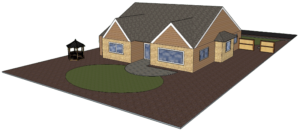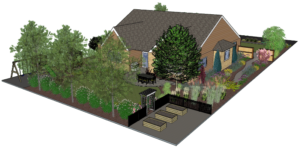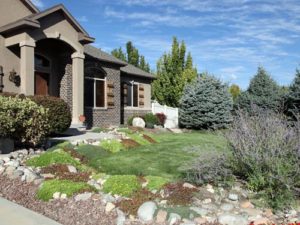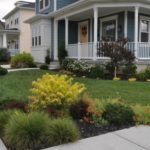[vc_row][vc_column][vc_custom_heading text=”Water Wise It: Landscape” font_container=”tag:h1|font_size:28|text_align:center|color:%23000000″ google_fonts=”font_family:Lato%3A100%2C100italic%2C300%2C300italic%2Cregular%2Citalic%2C700%2C700italic%2C900%2C900italic|font_style:400%20regular%3A400%3Anormal” css=”.vc_custom_1494416453005{padding-bottom: 10px !important;}”][vc_tta_accordion style=”flat” shape=”square” color=”white” spacing=”5″ gap=”5″ active_section=”1″][vc_tta_section title=”Functional Landscapes” tab_id=”1492132511365-6178d984-35e088e1-68ec”][vc_udesign_content_block bg_image=”” bg_color=”” max_bg_width=”yes” font_color=”#000000″ content_padding=”15px 0″ class=””]

Functional Landscapes
In Utah and the Inter Mountain Region we value our way of life and that includes enjoying our time outdoors. Our landscapes reflect our love of the environment, but we often sacrifice a precious resource, water, to achieve the results we want.
A traditional landscape in Utah is dominated by lawn areas, and if you have children that use those areas consistently that may be appropriate. But in many cases installing lawn as the focal point of your landscape is not very Water Wise. Focus on functionality in your landscape and you will be able to create an area that is visually appealing, does not waste water, and is used to its full extent.
You should keep in mind at least two things while you are designing (or remodeling) your landscape. 1. How will you use the landscape. 2. How will you maintain your landscape.
How will you use your landscape?
 If you are a family with children who love to play sports in the yard, a larger open space with turf as ground cover may be necessary to allow them the space to kick a soccer ball or play catch. But if your household consists of pets and adults rather than children, smaller lawn areas are recommended.
If you are a family with children who love to play sports in the yard, a larger open space with turf as ground cover may be necessary to allow them the space to kick a soccer ball or play catch. But if your household consists of pets and adults rather than children, smaller lawn areas are recommended.
If your house is East facing and you want to use your landscape to entertain on summer nights, focus on gathering areas and plant trees along the west side of your landscape to provide shade.
How will you maintain your landscape?

One of the primary considerations when you create a functional landscape is how you will maintain it. Consider first how you will water each area of your landscape and group plants according to your landscape zones and the water requirements of plants in that zone. Trees will require different amounts of water than lawn or flowers and should be planted in separate zones to maximize water conservation efforts. Drip irrigation is effective in flower beds but may not be as efficient in lawn areas.
By concentrating on variety, functionality, and watering zones within your landscape you can create an area around your home that is beautiful and Water Wise.[/vc_udesign_content_block][/vc_tta_section][vc_tta_section title=”LocalScapes” tab_id=”1492132609198-27e1ccba-28a788e1-68ec”][vc_udesign_content_block bg_image=”” bg_color=”” max_bg_width=”yes” font_color=”#000000″ content_padding=”15px 0″ class=””]

What are LocalScapes?
The Localscape approach is a series of landscaping patterns and practices that takes into account Utah’s unique climate. It’s good landscape design, simplified. Now you can have a landscape that works for where you live.
LocalScapes are designed for Utah, have excellent curb appeal, have lower maintenance, are water effiicient and have simplified irrigation. But most of all, LocalScapes are more functional than the traditional Utah landscape. There are 5 steps to creating a LocalScape.
Central Open Space
 If you use an irrigation system, you can prevent frustration by designing your landscape to fit your sprinklers instead of forcing sprinklers to fit your landscape. Keeping lawn in a central open shape allows sprinkler systems to work efficiently. Your central open shape can also be other materials like gravel, pavement, pavers, ground cover, or any low-lying, relatively flat material—especially if you want something even more water thrifty.
If you use an irrigation system, you can prevent frustration by designing your landscape to fit your sprinklers instead of forcing sprinklers to fit your landscape. Keeping lawn in a central open shape allows sprinkler systems to work efficiently. Your central open shape can also be other materials like gravel, pavement, pavers, ground cover, or any low-lying, relatively flat material—especially if you want something even more water thrifty.
Gathering Areas
 Rethinking maintenance as part of landscape design saves time, energy and more of your Saturday. For example, placing gathering areas like patios, decks, or informal seating outside of your lawn means fewer areas to irrigate and maintain.
Rethinking maintenance as part of landscape design saves time, energy and more of your Saturday. For example, placing gathering areas like patios, decks, or informal seating outside of your lawn means fewer areas to irrigate and maintain.
Activity Zones
 Just like gathering areas, activity zones like trampolines, play sets, sheds, and hot tubs should be placed outside of your lawn area. You get the same benefits plus no more objects to mow around.
Just like gathering areas, activity zones like trampolines, play sets, sheds, and hot tubs should be placed outside of your lawn area. You get the same benefits plus no more objects to mow around.
Paths
Planting Beds
 Choosing the right plants to fill in the rest of your landscape will save you money and time because Utah-friendly plants thrive here.
Choosing the right plants to fill in the rest of your landscape will save you money and time because Utah-friendly plants thrive here.
Click here to learn more about Localscapes, download designs, or to register for classes.
[/vc_udesign_content_block][/vc_tta_section][vc_tta_section title=”Inter Mountain Region Plant List” tab_id=”1492132608394-0caaeca2-ab3688e1-68ec”][vc_udesign_content_block bg_image=”” bg_color=”” max_bg_width=”yes” font_color=”#000000″ content_padding=”15px 0″ class=””]

Selecting plants that are beautiful year round and creating a landscape that has beautiful color throughout Utah’s diverse seasons while being Water Wise can be a daunting task. Jordan Valley Conservation Garden has created a wonderful searchable database with pictures of different Water Wise plants. You can check it out here. https://conservationgardenpark.org/plants
If you have further questions please contact us through our contact page or email us directly at info@waterwiseit.com.
[/vc_udesign_content_block][/vc_tta_section][vc_tta_section title=”Sprinkler Systems” tab_id=”1492132607797-70f7f585-e6a888e1-68ec”][vc_udesign_content_block bg_image=”” bg_color=”” max_bg_width=”yes” font_color=”#000000″ content_padding=”15px 0″ class=””] Installing a sprinkler or irrigation system for your lawn &/or garden is perhaps one of the few home improvement projects that actually makes your life much easier. Hand watering gardens, flower beds, or lawns-moving a lawn sprinkler attached to the hose every 20 minutes-is not most homeowners’ idea of fun. Hose-draggers are usually more conscientious about watering their landscapes but it takes much more time and effort.
Installing a sprinkler or irrigation system for your lawn &/or garden is perhaps one of the few home improvement projects that actually makes your life much easier. Hand watering gardens, flower beds, or lawns-moving a lawn sprinkler attached to the hose every 20 minutes-is not most homeowners’ idea of fun. Hose-draggers are usually more conscientious about watering their landscapes but it takes much more time and effort.
A sprinkler system automates this entire process while minimizing the concern of whether or not your yard is getting the proper amount of water it needs. However, this can create complacency and lead to wasting water. A properly designed and installed sprinkler system addresses many different concerns in a landscape.
Sprinkler System Components
Sprinkler systems are composed of a few main parts. Controllers are computerized systems that act as the brains of the system telling Valves when to open and deliver water to the Sprinkler Heads. It is easy to set a controller and forget it but this is not a very water wise means of operation. Water needs in landscapes change often depending on natural precipitation, temperature, and humidity. Ensuring that all parts of your system are operating effectively and then watching your landscape and responding to visual signs of its maintenance needs is far more effective way to maintain your yard.
Plant Zones

Irrigation zones are an element of landscape irrigation design that allows your system to target water distribution with precision. The premise behind “irrigation zones” is a simple element of planning the system. Zoning basically ensures that plants in Zone A of your landscape require X amount of water while Zone B should only require Y amount, and so on.
Establishing irrigation zones according to plant type and designing your sprinkler system accordingly will make you more Water Wise and results in costs savings.
Using irrigation zones will allow you to utilize a variety of irrigation methods as well (misters, rotation head sprinklers, drip irrigation, etc.)
Water Conservation Tips for Sprinkler Systems
Here a few tips to help you have a lush, green landscape without draining the rivers and your bank account…
- Don’t drown everything
The greatest waste of water comes from applying too much, too often. Instead of watering for a long session, water a few times for shorter periods and take 15-minute breaks between each session. This will allow time for the water to soak in, while minimizing run off. (Especially in the hard clay soils).
- Watch the clock
Optimum watering hours are from 4 a.m. to 10 a.m., when the sun is low winds are calm and temperatures are cool. Midday watering tends to be less efficient due to water loss through evaporation and windy conditions during the day. Watering during evening hours isn’t the best idea either. Wet lawns and plant leaves can remain wet overnight-an irresistible invitation for fungus and other diseases to develop and grow.
- Divide by zones

Picture provided by Localscapes Different plants need different amounts of water. Divide your yard and landscape areas into separate irrigation zones so grass can be watered separate from ground covers, shrubs and trees. Both sprinkler and drip irrigation can be incorporated to achieve more efficient use of water.
- Water only things that grow
With a subsurface sprinkler system, proper sprinkler head alignment is paramount in order to water only living plants, not sidewalks, driveways or the street. A properly adjusted sprinkler head should spray large droplets of water instead of a fine mist. This will minimize evaporation and wind drift.
- Use drip irrigation effectively
 When it comes to watering individual trees, flowerbeds, potted containers or other non-grassy areas, consider applying water directly to the roots using low volume drip irrigation. This approach will reduce water waste from evaporation or runoff. It will also prevent unwanted weeds from growing. A basic drip system consists of a series of tubes that have holes at intervals. The location of the open holes is tailored to irrigate specific plants more efficiently. For instance, if you have certain plants spaced at two-foot intervals, the corresponding holes in the drip system will also be spaced at two-foot intervals. Water will be distributed only where the plants are stationed and not in the areas between them.
When it comes to watering individual trees, flowerbeds, potted containers or other non-grassy areas, consider applying water directly to the roots using low volume drip irrigation. This approach will reduce water waste from evaporation or runoff. It will also prevent unwanted weeds from growing. A basic drip system consists of a series of tubes that have holes at intervals. The location of the open holes is tailored to irrigate specific plants more efficiently. For instance, if you have certain plants spaced at two-foot intervals, the corresponding holes in the drip system will also be spaced at two-foot intervals. Water will be distributed only where the plants are stationed and not in the areas between them. - Perform routine inspections
If you’re watering at the proper time of day (early morning hours), a problem may occur and not be discovered until it is too late. Periodically examining your sprinklers to make certain everything is in proper working order can save a lot of headaches. A clogged head or a torn line can wreak havoc on your landscape and water bill.
- Be rain and season smart
Adjust your sprinkler system as the seasons and the weather change. An easy way to accomplish this is to install a shut-off device in your system that automatically detects rain or moisture. Check out the Technology page of this website for more information on Soil Moisture Sensors, Evapotranspiration Sensors and Smart Controllers.
The biggest factor that promotes water conservation is careful observation by the system user. By learning signs the landscape provides as to what maintenance is necessary and responding to them instead of leaving systems on auto pilot and forgetting about them you will be able to minimize the amount of water wasted in your landscape.
For more information or specific questions about how to further Water Wise your Landscape please contact us by email at info@waterwiseit.com.
[/vc_udesign_content_block][/vc_tta_section][/vc_tta_accordion][/vc_column][/vc_row][vc_row][vc_column][vc_custom_heading text=”SPONSORS” font_container=”tag:h1|font_size:28|text_align:center|color:%23000000″ google_fonts=”font_family:Lato%3A100%2C100italic%2C300%2C300italic%2Cregular%2Citalic%2C700%2C700italic%2C900%2C900italic|font_style:400%20regular%3A400%3Anormal” css=”.vc_custom_1492186290568{padding-bottom: 5px !important;}”][vc_images_carousel images=”123,122,121,51,52,53,54,11″ img_size=”full” onclick=”custom_link” custom_links_target=”_blank” slides_per_view=”4″ hide_pagination_control=”yes” wrap=”yes” custom_links=”#E-8_aHR0cCUzQSUyRiUyRnd3dy5tYXJrZXRpbmdzcG90b24uY29tJTJDaHR0cCUzQSUyRiUyRnd3dy5nb29nbGUuY29tJTJDaHR0cCUzQSUyRiUyRnd3dy5mYWNlYm9vay5jb20lMkNodHRwJTNBJTJGJTJGd3d3LnlhaG9vLmNvbSUyQ2h0dHAlM0ElMkYlMkZ3d3cubWFya2V0aW5nc3BvdG9uLmNvbQ==”][/vc_column][/vc_row][vc_row][vc_column][vc_custom_heading text=”RESOURCES” font_container=”tag:h1|font_size:28|text_align:center|color:%23000000″ google_fonts=”font_family:Lato%3A100%2C100italic%2C300%2C300italic%2Cregular%2Citalic%2C700%2C700italic%2C900%2C900italic|font_style:400%20regular%3A400%3Anormal” css=”.vc_custom_1492186299680{padding-bottom: 5px !important;}”][/vc_column][/vc_row][vc_row][vc_column width=”1/4″][vc_single_image image=”145″ alignment=”center” onclick=”custom_link” img_link_target=”_blank” link=”http://www.chanshare.com/”][/vc_column][vc_column width=”1/4″][vc_single_image image=”146″ alignment=”center” onclick=”custom_link” img_link_target=”_blank” link=”https://localscapes.com/”][/vc_column][vc_column width=”1/4″][vc_single_image image=”148″ alignment=”center” onclick=”custom_link” img_link_target=”_blank” link=”https://extension.usu.edu/yardandgarden/index”][/vc_column][vc_column width=”1/4″][vc_single_image image=”147″ alignment=”center” onclick=”custom_link” img_link_target=”_blank” link=”http://slowtheflow.org/index.php/”][/vc_column][/vc_row][vc_row][vc_column][/vc_column][/vc_row]
